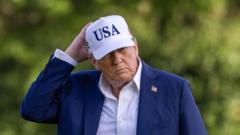Despite assertive promises from the Trump administration, the anticipated trade agreements are faltering, revealing potential pitfalls of the ongoing trade strategy.
Trump Postpones Tariffs Amid Global Trade Tensions

Trump Postpones Tariffs Amid Global Trade Tensions
In a move signaling uncertainty in international trade relations, Trump extends tariff deadline as nations respond vigorously.
In a surprising move, the Trump administration has decided to delay the implementation of tariffs initially set to take effect on July 9, extending the deadline to August 1, with hints of further postponements. Such delays reverberate through the global trading landscape, where other nations have begun to respond with their own strategies. Treasury Secretary Scott Bessent noted that the focus has narrowed to 18 countries responsible for a significant portion of the U.S. trade deficit, yet the promised “90 deals in 90 days” appear increasingly unrealistic.
The atmosphere among U.S. trading partners has soured. Countries like Japan and South Korea are feeling the brunt of the stalled negotiations, with Japan’s finance minister openly expressing discontent and hinting at leveraging its substantial holdings of U.S. debt. This reflects a broader sentiment among nations that a hardball approach may be met with similar tactics, raising the stakes in an already turbulent economic environment.
Markets, meanwhile, reacted calmly to these delays, potentially emboldening other nations to prolong negotiations, which might lead to heightened tensions. The consistency of declining export numbers, particularly from China, juxtaposed with increasing exports to other global markets indicates shifts in trade dynamics. While U.S. tariff revenues were reportedly up, the overall economic picture is complicated by a weakened dollar and increases in trade with other nations.
Tariffs, now averaging around 15%—a stark increase from historical rates—raise concerns about long-term impacts on the U.S. economy and relationships with global trade partners. As the dance of negotiations continues, the world watches closely to see if the calm market response will hold or if tensions will rise once more.
The atmosphere among U.S. trading partners has soured. Countries like Japan and South Korea are feeling the brunt of the stalled negotiations, with Japan’s finance minister openly expressing discontent and hinting at leveraging its substantial holdings of U.S. debt. This reflects a broader sentiment among nations that a hardball approach may be met with similar tactics, raising the stakes in an already turbulent economic environment.
Markets, meanwhile, reacted calmly to these delays, potentially emboldening other nations to prolong negotiations, which might lead to heightened tensions. The consistency of declining export numbers, particularly from China, juxtaposed with increasing exports to other global markets indicates shifts in trade dynamics. While U.S. tariff revenues were reportedly up, the overall economic picture is complicated by a weakened dollar and increases in trade with other nations.
Tariffs, now averaging around 15%—a stark increase from historical rates—raise concerns about long-term impacts on the U.S. economy and relationships with global trade partners. As the dance of negotiations continues, the world watches closely to see if the calm market response will hold or if tensions will rise once more.




















